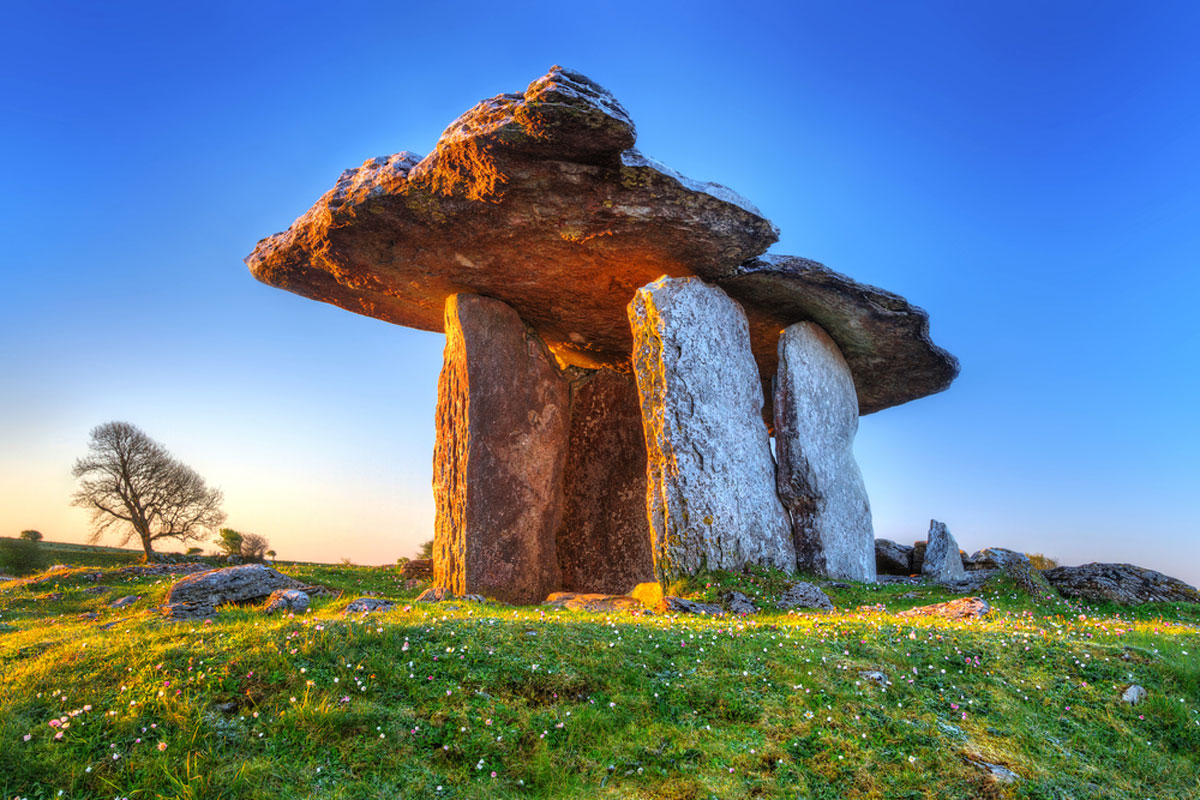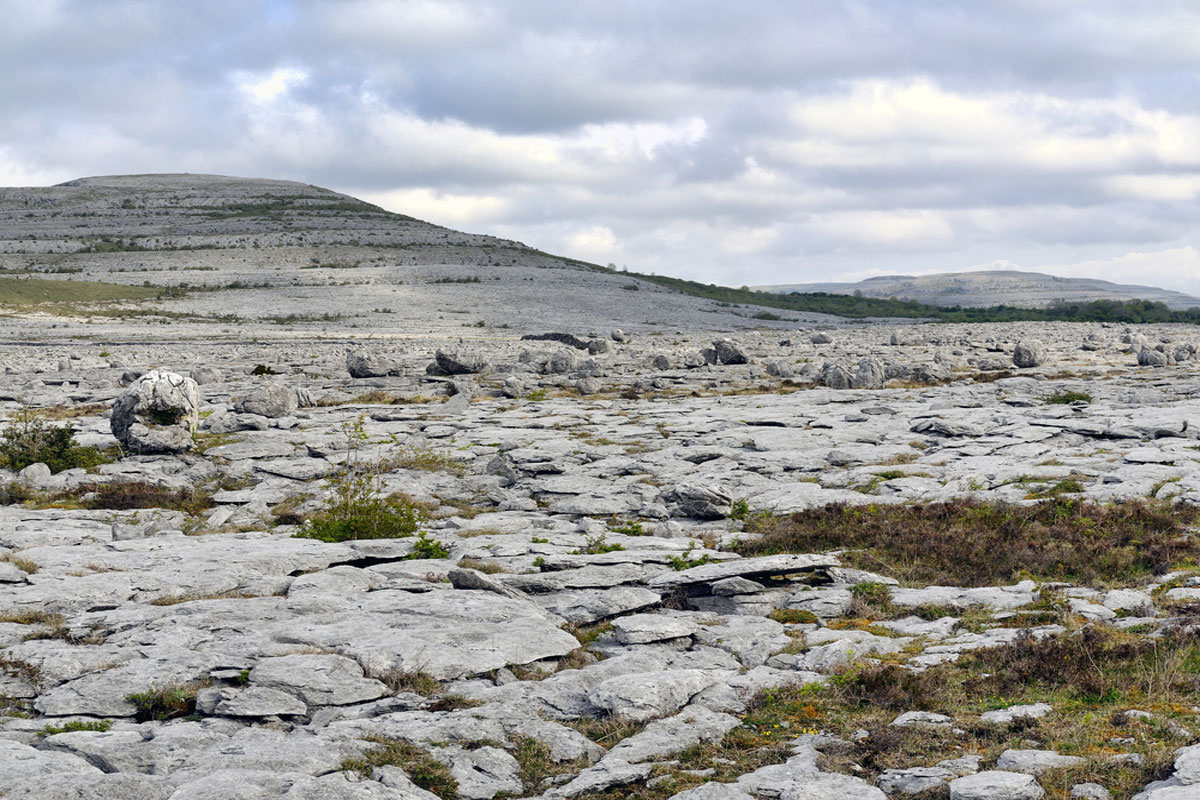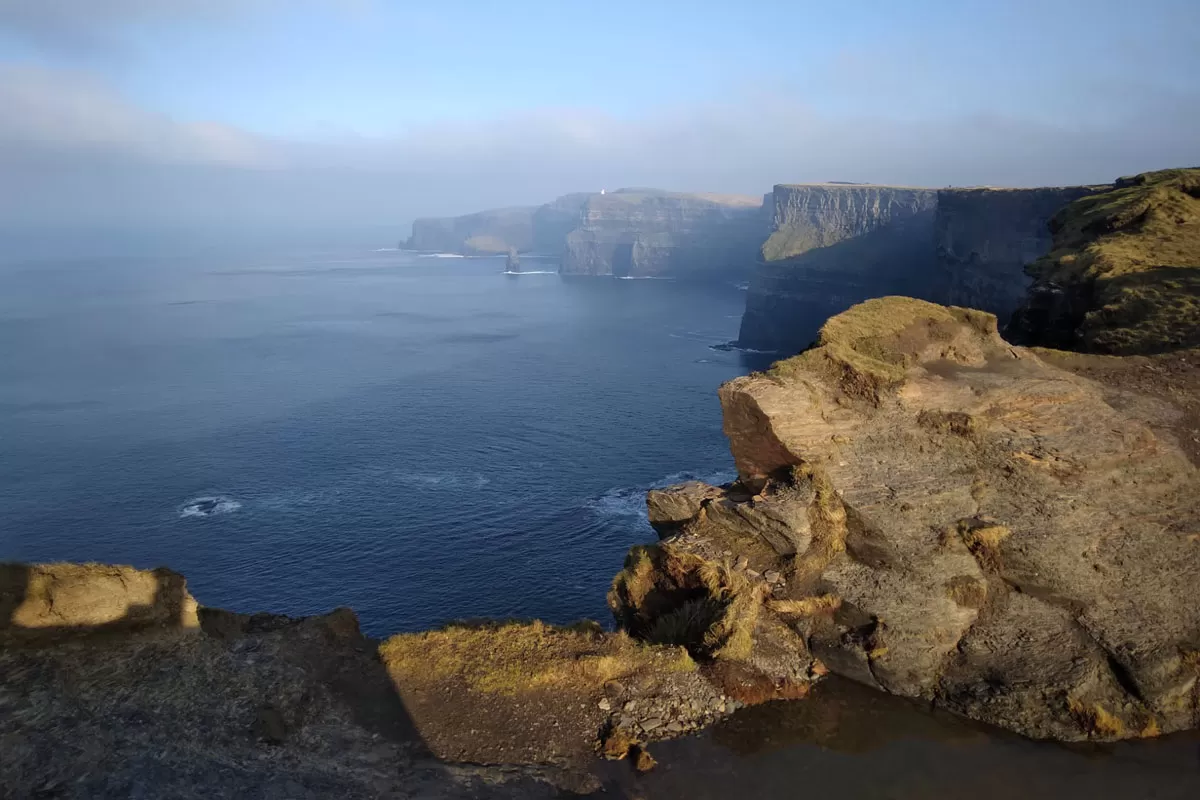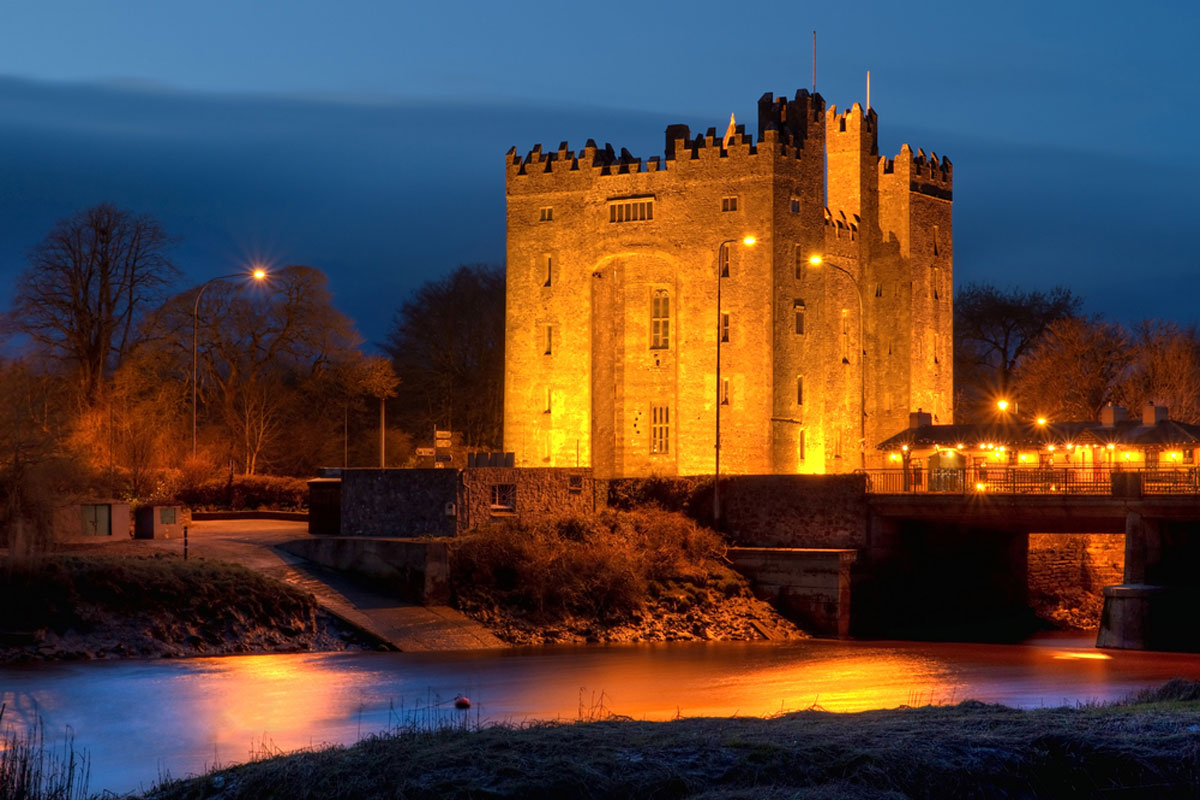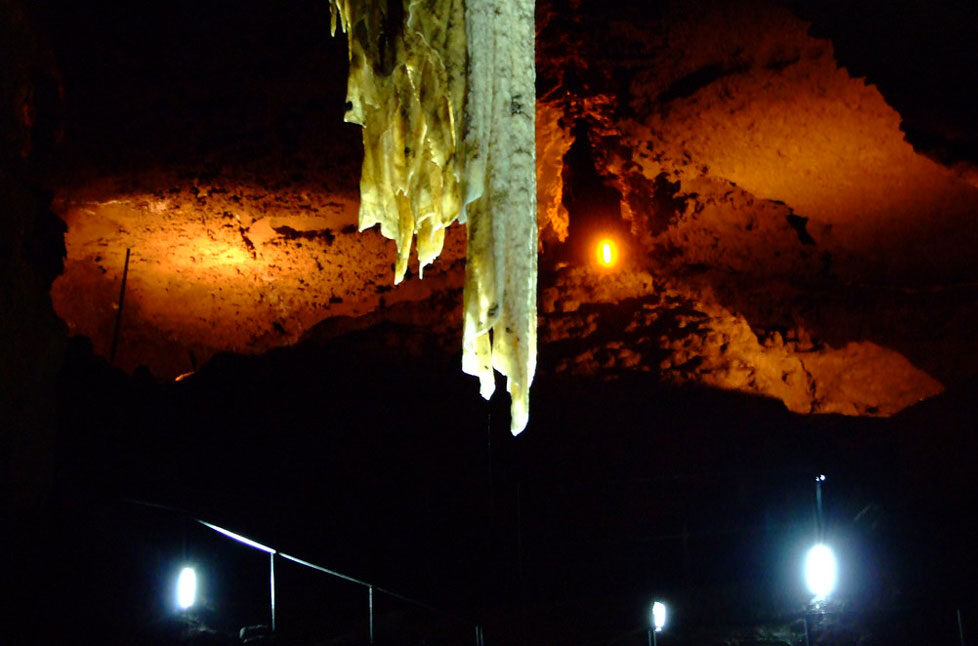Gateway to the Past
High on the limestone expanse of the Burren in County Clare stands a haunting and powerful monument — Poulnabrone Dolmen, one of Ireland’s oldest and most iconic megalithic tombs. Silhouetted against windswept skies and open rock, its name means “Hole of the Quernstones” in Irish (Poll na Brón), hinting at the mysterious ancient world from which it came.
A Portal into Prehistory
Poulnabrone is what archaeologists call a portal tomb, a type of megalithic structure named for its two tall portal stones that seem to form a doorway into another realm. It dates to the Neolithic period, around 4200 to 2900 BCE — making it over 5,000 years old.
This ancient tomb predates the pyramids of Egypt and was constructed at a time when farming had just taken root in Ireland. Communities were settling, planting crops, and honoring their dead in monumental ways. Poulnabrone wasn’t just a burial site; it was a sacred space where the worlds of the living and the dead met.
The Structure Itself
The dolmen consists of:
- Two portal stones (each over 6 feet tall)
- A capstone — a massive slab laid horizontally across the top
- Several supporting orthostats or upright stones
- An entrance chamber underneath
It stands alone on the stark Burren landscape, where the limestone karst provides a dramatic and timeless setting. There’s no sign of mortar or metal — just ingenuity, muscle, and reverence. The builders moved and erected these massive stones using only stone tools and wooden levers.
Why Here?
The Burren may seem desolate today, but in the Neolithic period, it was a fertile, forested region. Poulnabrone’s elevated position would have made it visible for miles — possibly serving as a territorial marker, a ritual centre, or a memorial to ancestors.
What Lies Beneath
Though Poulnabrone Dolmen had stood for millennia, its secrets remained largely hidden until the 1980s, when archaeologists carried out an excavation beneath the monument. What they uncovered revealed an extraordinary window into Neolithic life and death.
Human Remains: A Community Tomb
Beneath the dolmen’s imposing capstone, archaeologists discovered the disarticulated remains of at least 33 individuals — men, women, and children. These remains dated back over 5,000 years, with the majority from the Neolithic period (around 3800–3200 BCE), and a few from the early Bronze Age, suggesting the site held long-lasting ritual importance.
The bones were not buried whole. Instead, they were scattered and arranged, indicating that the bodies had been left elsewhere to decompose, and then selected bones were brought to the dolmen. This points to complex funerary practices and a belief system that honored ancestors in ceremonial ways.
Grave Goods and Artefacts
Alongside the bones, the dig revealed pottery shards, stone tools, a polished stone axe, and beads — items likely left as grave goods. These suggest that Poulnabrone was not just a place of burial, but of ritual significance, possibly visited repeatedly for ceremonies or to honor the dead.
The careful selection and placement of objects point to a symbolic world we can only glimpse. These were people who saw death not as an end, but as a journey, and the dolmen as a threshold between realms — a portal tomb in every sense of the word.
Health and Lifestyle Clues
Analysis of the remains offered fascinating details:
- Most of those buried were adults aged 30 or older
- Evidence of arthritis, tooth decay, and malnutrition was present
- Some skulls showed signs of injury, hinting at violence or conflict
Yet despite hardships, these were skilled communities — farmers, toolmakers, and ritualists — with deep connections to their land and dead.
The Sacred Landscape of the Burren
To truly understand Poulnabrone Dolmen, one must look beyond the stones and into the land itself. The dolmen rises out of the heart of the Burren, a haunting and otherworldly expanse of exposed limestone pavement in County Clare, unlike anywhere else in Ireland — or the world.
A Land of Stone and Silence
The Burren takes its name from the Irish word Boireann, meaning “rocky place.” From above, it resembles a vast, cracked skin of the earth — a seemingly barren, wind-whipped plateau. But to those who know it, the Burren is teeming with life, history, and mystery.
Walking the Burren is like stepping into a timeless world. Deep fissures (called grikes) run through the limestone pavement, creating natural pathways and hiding pockets of rare flora. Wildflowers from Alpine, Arctic, and Mediterranean regions grow side by side — a phenomenon unique to this location.
Why Here?
It’s no coincidence that Poulnabrone was built in such a striking landscape. In Neolithic times, this area would have had more vegetation, but the dramatic rock formations would still have stood out. The dolmen’s elevated position on this karst limestone plateau meant it could be seen from miles around — making it an ideal place for a communal or ceremonial focal point.
This wasn’t just a burial site — it was a stage for ritual, a landmark for identity, and likely a spiritual centre. The very ground beneath it, cracked and ancient, would have felt alive and sacred to those who walked it thousands of years ago.
The Burren as a Ritual Landscape
Poulnabrone is not alone. The Burren is dotted with over 90 megalithic tombs, ringforts, fulachtaí fia (ancient cooking sites), and holy wells — suggesting a deeply ritualised and inhabited land. For Neolithic communities, the Burren was not a lifeless wilderness — it was a place of connection to ancestors, the earth, and the cosmos.
Even today, visitors describe a strange calmness at Poulnabrone — a feeling of being watched over, of stepping outside time. The quiet, windblown rocks seem to echo with memories not your own.
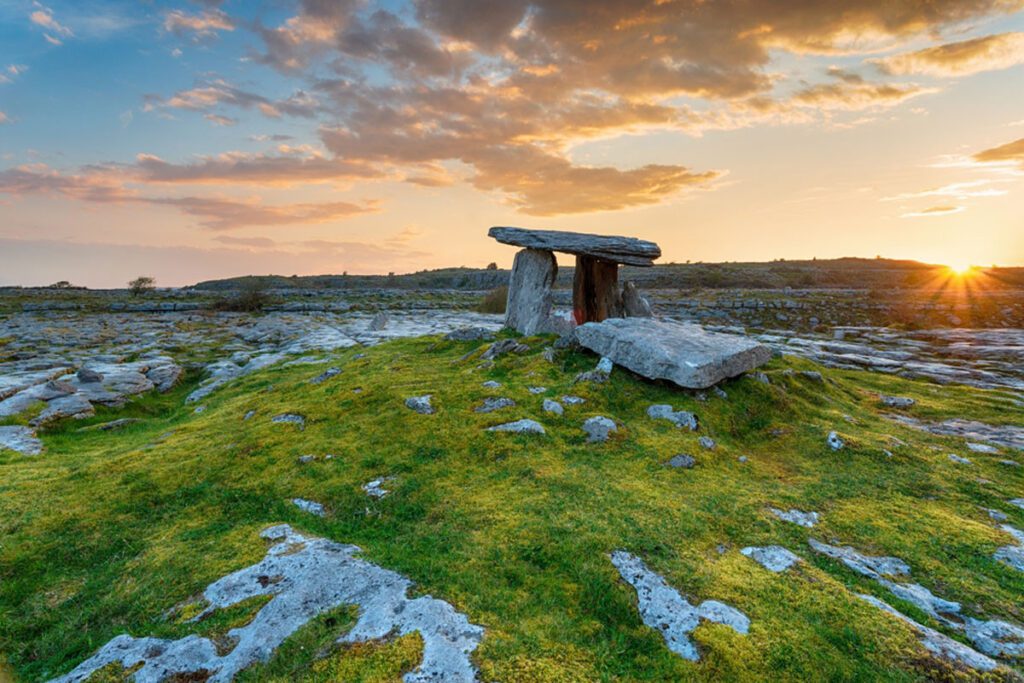
Myth, Legend, and Living Memory
Long after the last Neolithic farmer walked the Burren, Poulnabrone Dolmen remained — silent, unmoving, yet never forgotten. Like many ancient monuments in Ireland, it became woven into the fabric of myth, folklore, and local legend, acquiring new meanings with each passing generation.
Portal to the Otherworld
Across Ireland, dolmens and other megalithic tombs were often called “Diarmuid and Gráinne’s beds” or “fairy portals.” The belief was that these stone structures weren’t merely graves but doorways to the Otherworld — places where the veil between the mortal realm and the spirit world was thin.
Poulnabrone, sitting exposed on the eerie Burren, was seen as just such a place — a liminal zone where time bends and the spirits of the ancestors might still linger. Even into the 20th century, many locals avoided tampering with the stones, believing it could bring bad luck or provoke the ire of the “Good People” (the fairies).
Guardians and Ghosts
Some tales speak of phantom figures near the dolmen — shadowy guardians seen at dusk or strange lights flickering above the stones. It was said that those who visited disrespectfully, or at the wrong time, might find themselves lost on the Burren, wandering in circles, only to emerge confused and shaken hours or even days later.
These stories may seem fanciful, but they reflect a deep reverence and spiritual caution felt toward such ancient sites. In a country where oral tradition runs deep, the dolmen became part of the landscape of the imagination, as well as the earth.
Folklore as Cultural Memory
The persistence of these legends — passed down through generations — suggests that even when the original builders and meanings were forgotten, the dolmen remained a place of power. Myth became a way for later communities to make sense of the monument: a new language for an old mystery.
Today, Poulnabrone is more than a tourist site. It is a storyteller, whispering of lives lived and lost, of ancient hands that raised the stones, and of the countless tales that grew in their shadow.
A Monument for the Ages
Standing stoically on the windswept limestone of the Burren, Poulnabrone Dolmen continues to captivate all who visit. Though over five millennia have passed since its first stones were raised, its presence remains undiminished — a testament to Ireland’s ancient soul, and to the enduring human desire to remember and revere.
Preserving a National Treasure
Today, Poulnabrone is under the protection of the Office of Public Works (OPW) and is recognized as one of Ireland’s most significant megalithic tombs. A low wooden barrier now encircles the dolmen, preventing erosion and safeguarding the monument for future generations, while still allowing for intimate and respectful viewing.
Signage onsite offers archaeological insights, but nothing quite prepares visitors for the emotional impact of seeing it in person. The scale, the stillness, the silence — all combine to evoke a profound sense of time, memory, and mortality.
A Site of Pilgrimage
Poulnabrone is no longer a tomb in active use, but it remains a place of pilgrimage — not religious, perhaps, but spiritual. Visitors come not only for the history or the photo opportunity but to feel something ancient, to stand where others stood five thousand years ago, and to reconnect with the land, with the past, and with themselves.
Artists, poets, historians, and spiritual seekers all find inspiration here. For many, Poulnabrone embodies something eternal: the resilience of the Irish people, the continuity of tradition, and the power of place.
Symbol of Irish Heritage
In a modern world full of fast change and fleeting trends, Poulnabrone Dolmen offers something rare: stillness. It stands as a symbol of endurance, mystery, and connection — to ancestors, to the natural world, and to a time when people lived close to the earth and honored their dead with stone and ceremony.
Whether you view it as an archaeological site, a sacred monument, or simply a beautiful mystery, Poulnabrone continues to do what it has always done: draw people together, across time and place, in awe and wonder.
Natural Attractions
- Cliffs of Moher – Towering sea cliffs offering breathtaking views of the Atlantic Ocean.
- The Burren – A unique limestone karst landscape with rare flora and ancient archaeological sites.
- Loop Head Peninsula – A scenic coastal area with dramatic cliffs, a historic lighthouse, and panoramic views.
- Caher Valley Loop – A picturesque walking trail through lush landscapes and limestone terrain.
- Aillwee Cave – An underground cave system with stalactites, stalagmites, and a birds of prey center.
Historical and Cultural Sites
- Bunratty Castle and Folk Park – A 15th-century castle surrounded by a recreated historic Irish village.
- Poulnabrone Dolmen – An ancient portal tomb dating back to the Neolithic period.
- Scattery Island – A historic island featuring monastic ruins, a round tower, and stunning landscapes.
- Ennis Friary – A medieval friary known for its intricate stone carvings and rich history.
- Dysert O’Dea Castle – A 15th-century tower house with an adjacent archaeological trail.
Lakes and Water Activities
- Lough Derg – A large lake perfect for boating, fishing, and scenic cruises.
- Doonbeg Beach – A beautiful beach popular for surfing and coastal walks.
- Fanore Beach – Known for its golden sands and tranquil atmosphere, ideal for relaxation.
- Clare River – A serene spot for kayaking, canoeing, and birdwatching.
Scenic Drives and Villages
- Doolin – A charming village known as the gateway to the Aran Islands and a hub for traditional Irish music.
- Lahinch – A seaside town famous for surfing, beach walks, and its championship golf course.
- Kilfenora – Home to the Burren Centre and Kilfenora Cathedral with its renowned high crosses.
- Quin – A picturesque village featuring Quin Abbey, a well-preserved Franciscan friary.
Unique Experiences
- The Aran Islands – Accessible via ferry, offering a glimpse into traditional Irish island life.
- Clare Equestrian Centre – Enjoy horse riding through scenic trails and coastal paths.
- Burren Perfumery – A boutique perfumery creating fragrances inspired by the Burren’s unique flora.
- Moher Hill Open Farm – A family-friendly attraction with animals, a play area, and panoramic views.
- Kilkee Cliff Walk – A less crowded but equally stunning alternative to the Cliffs of Moher.
County Clare offers an incredible mix of natural beauty, cultural heritage, and unique experiences, making it a must-visit destination in Ireland.
Helpful Resources




